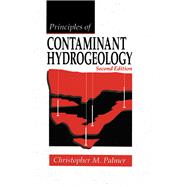
Note: Supplemental materials are not guaranteed with Rental or Used book purchases.
Purchase Benefits
What is included with this book?
| Geologic Frameworks for Contaminant Hydrogeologic Investigations | |
| Introduction | |
| Groundwater Occurrence and Geology of Aquifers | |
| A Brief Review of Unsaturated and Saturated Geologic Environments | |
| Introduction to Alluvial-Filled Basins and Sedimentary Depositional Environment | |
| A Brief Review of Groundwater Movement | |
| Conceptual Approach to Contaminant Hydrogeologic Investigations | |
| What is Important in Initial Site Aquifer Investigation Approach? | |
| An Example of "Changeable" Aquifers | |
| Contaminant Pathways - Subsurface Investigation and Monitoring Approach | |
| Introduction | |
| Contaminant Properties Affecting Transport | |
| Contaminant Pathways Through the Vadose Zone | |
| Contaminant Movement in the Aquifer | |
| Contaminant Movement in Fractured Rock | |
| Contaminant Movement Between Aquifers | |
| Locating the Contaminant Plume - the Initial Approach | |
| Overview of the Report and Data Analysis | |
| Example Approach to a Site Investigation | |
| Example of Modifying the Monitoring System at a Closed Landfill | |
| Summary | |
| Subsurface Exploration, Sampling, and Mapping | |
| Introduction | |
| Subsurface Exploration Program Approach | |
| Geological Data Collection Goals | |
| Introduction to Subsurface Drilling and Sampling | |
| Soil Sampling Methods | |
| Exploratory Borehole Logging | |
| Subsurface Mapping and Strata Correlation | |
| Example of Integrating Sampling and Drilling in a Deep Borehole | |
| Summary | |
| Groundwater Monitoring Well Design and Installation | |
| Introduction | |
| Monitoring Well Design | |
| Example of Monitoring Well Installation into the "A" Aquifer | |
| Monitoring Well Development | |
| Well Completions for Different Monitoring Situations | |
| Well Abandonment | |
| Groundwater Monitoring Well Sampling | |
| Introduction | |
| Sampling Plans and Protocol | |
| Selection of Chemical Analytical Laboratory | |
| Monitoring Well Sampling - Prefield Sampler Preparation | |
| Sample Bias | |
| Example - Field Protocol for Sampling a Monitoring Well | |
| Liquid Sampling in Vadose (Nonsaturated) Environments | |
| Introduction to Regulatory and Legal Framework | |
| Introduction | |
| Overview of Federal Law | |
| Selected State and Local Regulations | |
| Agency Involvement and Negotiation with the Consultant | |
| Expert Review | |
| Summary | |
| Introduction to General Groundwater Geochemistry | |
| Introduction | |
| Inorganic Composition and Quality | |
| Regulations Establishing Drinking Water Quality Standards | |
| Natural Contaminants | |
| Biological Contaminants | |
| Organic Chemical Contaminants | |
| Analytical Laboratories | |
| Long-Term Trends of Chemical Data Collected in Monitoring Wells | |
| Example: Is a Low Concentration of Contaminant Actually There? | |
| Aquifer Analysis | |
| Introduction | |
| Considerations Prior to the Aquifer Test | |
| Instantaneous Discharge Test (Slug Test) | |
| Pump Test Equipment | |
| Review of Selected Pumping Test Data Analysis | |
| Aquifer Testing in Fractured Rock | |
| Computer Modeling for Groundwater Pumping and Remediation Scenarios | |
| Possible Pumping Approaches for Contaminant Capture | |
| Summary | |
| Remediation and Cleanup | |
| Introduction | |
| Conceptual Approach to Site Cleanup | |
| Overview of Response Actions and Cleanup Technology | |
| Selecting Applicable Remedial Alternatives | |
| Screening the Applicable Remedial Alternatives | |
| Implementation of Corrective Action | |
| Finalizing the Cleanup Plan | |
| Example of Attaining Closure of a "Toxics" Site | |
| Example of Soil Vapor Cleanup for Client with Limited Funds and Marginal Site Conditions | |
| Example of a Closed-Loop Subsurface Bioremediation Groundwater Cleanup | |
| Vadose Soil Cleanup Remediation Plan Development for a 2, 4-D Spill | |
| References | |
| Index |
The New copy of this book will include any supplemental materials advertised. Please check the title of the book to determine if it should include any access cards, study guides, lab manuals, CDs, etc.
The Used, Rental and eBook copies of this book are not guaranteed to include any supplemental materials. Typically, only the book itself is included. This is true even if the title states it includes any access cards, study guides, lab manuals, CDs, etc.